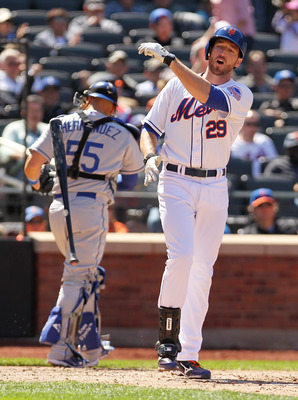So it seems the Mets are prepared to go into spring training and have Ike Davis and Lucas Duda duking it out to see who the Mets’ first baseman is in 2014.
They’re both lefties, so there is no platoon scenario here. At the end of spring, one of those two men will be standing victorious, and the other better get used to picking splinters.
I am still under the premise that the Mets would rather not start the season with Ike on the roster, but the latest news that the Mets are going to go into spring training with Davis should come as no surprise. I’m not so sure Davis is being brought back to compete for the job so much as Sandy Alderson would like to build his trade value.
If Davis is mashing in the spring, and some teams suffer some early season injuries, Alderson may finally get that pitching prospect he’s been holding out for. If no trade is made, the Mets may have the old Davis back. It’s a win, win situation…unless of course, Davis comes in and stinks up the joint this spring. The Mets would then be forced to decide if they leave spring training with Davis on the roster.
I did an analysis on Duda about a week ago (you can read it here). Today, we will look at Davis.
With Duda, we had to look at the numbers to see if there was a story regarding what was going on. But with Davis, it’s a little easier to see. His swing was a mess in 2013—plain and simple.
In all honesty, Davis’ swing is not all that different from Chris Davis‘ swing. Both hitters drop their hands as they recoil to generate power and bat speed—the difference with Ike is that he starts with his hand much higher than Chris does.
Take a look at Chris Davis’ swing below and you can see there isn’t much difference aside from where they start their hands, which is actually all the difference in the world.
Sometimes all it takes is a tweak, and hopefully Ike spent the winter tweaking his swing. When he is standing in the box, he uses a wide stance. This prevents the hitter from having a long stride, which can change their eye level during the swing.
The major issue I have with Ike Davis’ swing is that there is just way too much going on before the pitch arrives. He has to shorten his path to the ball. Like I said earlier, Chris Davis also drops his hands, but his path is shorter to the ball than Ike’s. This allows Chris Davis to take full advantage of his power by generating better bat speed. See a breakdown of Ike’s swing below.
In 2013, Davis started his swing with his hands very high, above his head. Then as the pitcher starts his motion, he drops his hands almost down to waist level, then has to bring them back up to the zone to get his hands in a position to hit. That is a ton of noise before he has to prepare for a 95 mph fastball. With all that going on, he almost has to be thinking fastball on every pitch in order to catch up to it, which is probably why he has so much trouble hitting the off-speed pitch.
When looking at some of Ike’s numbers in comparison to 2012, many of them did not show much of a drop off—his contact rate remained the same, and his swing percentage was the same. It boils down to the fact that he is not making the authoritative contact that he did in 2012 which led to 32 homeruns.
The major difference from 2012 to 2013 seemed to be the amount of fastballs Ike was seeing. The amount of breaking balls he saw remained flat. It seemed that the pitchers immediately recognized what they had to do to get Ike out after seeing his mechanically-broken swing.
The pitchers weren’t afraid to attack Ike with their fastball, and then they would use off-speed pitches out of the zone to get Ike to chase—sometimes it worked, and Ike looked ridiculous flailing at pitches out of the strike zone, and sometimes it didn’t, which would explain Ike’s higher walk rate in 2013.
The fix is simple—don’t drop the hands, load them straight back and throw them at the ball like Chris Davis does. See the ball, hit the ball. This will allow Ike to tap into his power—get around on the fastball and drive the off-speed pitch.
By limiting what he is doing before the pitch arrives, he will be able to trust his hands more and adjust to whatever pitch he sees. By keeping his hands between his shoulder and ear, he already has them in a good hitting position, and doesn’t have to make three movements before the pitch arrives to get them there. Simplify, simplify, simplify.
If Davis wants to get better he has to leave his comfort zone. As Thomas Edison said, “we shall have no better conditions in the future if we are satisfied with all those which we have at present.”
Davis has a swing that would surely get him in the beer-league softball hall of fame, but it’s not going to cut it in the big leagues.
A coach once told me that “if you show the ability to do something on the field once, it means that you always have the ability to do it again.” He meant that nothing happens by mistake in baseball. You either have the ability to do something or you don’t. Whether you repeat your feats is all up to you.
Ike has the ability to hit 30-plus homeruns as he displayed in 2012. That means he should be able to do it again. Whether he does it again is all up to him. However, doing it again in a Mets uniform isn’t a guarantee.
















